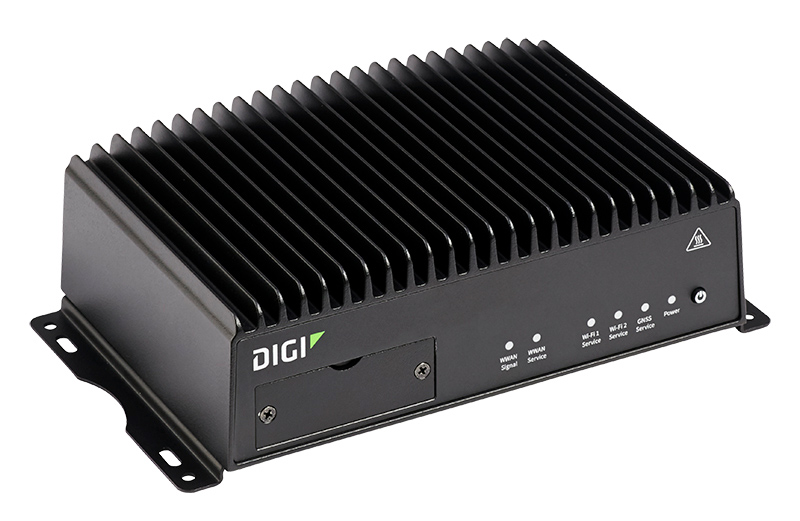现代公交系统采用蜂窝路由器,通过由接入点名称(APN)技术标识的分组数据网络网关连接到专用网络或互联网,以支持多种目的的通信。路由器内置的通过 APN 促进公共和私人通信的方法非常重要,因为这些方法会影响公交公司的业务成本。
在这篇文章中,我们将介绍这些关键的考虑因素,并分享 Digi 如何解决这一难题,帮助运输机构简化系统、提高安全性并降低成本。
公交系统:工作中的通信技术
几年前,公共交通机构主要负责将乘客从 A 点运送到 B 点。现在,除了运送乘客,这些机构还需要通过无线方式运送越来越多的数据。
如今,大多数公交车辆都会产生两种不同的数据流:车辆数据和乘客数据。车辆数据流与公共汽车或轨道车辆本身的运行有关,包括自动乘客计数 (APC)、收费和 CAD/AVL 数据(计算机辅助调度/自动车辆定位),以及与发动机和其他机械系统性能有关的数据。第二个数据流是乘客 Wi-Fi,这是许多公交公司免费为乘客提供的一种流行设施。
数据回程考虑因素
转运业务中的一个重要问题是,何时传输数据才能达到最佳效率并降低成本。
- 一些车辆运营系统(如收费系统)需要实时通信,因此它们利用蜂窝网络进行数据传输。
- 乘客 Wi-Fi 当然需要通过蜂窝网络进行实时数据传输,尽管其优先级低于车辆数据。
- 其他车辆运行系统,如视频安全和车辆维护系统,会产生大量数据,而这些数据通常不需要实时获取。这些数据可以在一天结束后车辆进入车库或车站时下载,并通过 Wi-Fi 传输,当然,Wi-Fi 的成本要比蜂窝网络低得多,尤其是对于大数据文件而言。
区分公共数据和私人数据
主要出于安全考虑,将这两个数据流分开非常重要。这通常需要在车顶部署两个独立的蜂窝路由器和两根天线。另一个替代方案是安装一个蜂窝路由器,并可选配第二个可现场升级的调制解调器,以便在未来某个日期部署乘客 Wi-Fi。 不过,还有一种成本更低的替代方案,可在首次安装时提供所需的性能和功能,而无需在未来进行现场升级。这就是双 APN 技术的用武之地。
一台路由器中的公共和专用 APN
 每个蜂窝设备都与一个特定的分组数据网络网关通信,该网关由其接入点名称(APN)唯一标识。APN 有公共 APN 和专用 APN 之分。车辆数据通常分配给专用 APN,以防止黑客攻击,并通过 IPsec VPN 运行。但现在,主要的蜂窝运营商都提供了分离式隧道,也称为双 APN 功能,在单个物理接口中,蜂窝路由器可以使用单个无线连接同时进行两个独立的数据会话。具有这种功能的设备可将乘客 Wi-Fi 的数据流量路由到公共网关,使公交乘客能够访问互联网。与此同时,车辆运行的数据流量会被路由到公交组织的专用网络网关。
每个蜂窝设备都与一个特定的分组数据网络网关通信,该网关由其接入点名称(APN)唯一标识。APN 有公共 APN 和专用 APN 之分。车辆数据通常分配给专用 APN,以防止黑客攻击,并通过 IPsec VPN 运行。但现在,主要的蜂窝运营商都提供了分离式隧道,也称为双 APN 功能,在单个物理接口中,蜂窝路由器可以使用单个无线连接同时进行两个独立的数据会话。具有这种功能的设备可将乘客 Wi-Fi 的数据流量路由到公共网关,使公交乘客能够访问互联网。与此同时,车辆运行的数据流量会被路由到公交组织的专用网络网关。
双 APN 提供了一种方法,可减少为不同目的维护不同设备所带来的混乱和成本。公交机构有时会安装由收费系统集成商提供的独立路由器,以处理这部分数据流量。但越来越多的公交机构选择将车载蜂窝路由器作为其内部 IT 基础设施的延伸,以简化操作并降低设备和服务成本。
Digi 提供一种特殊型号的 TX54,专门用于利用双 APN 技术来支持所有必需的回程方法、数据类型和优先级。 它就是 TX54-A112,具有两个独立并发的 Wi-Fi 接口和一个蜂窝接口。有了这种功能,运输机构就可以节省第二个蜂窝路由器和第二个天线的成本。然而,即使功能增强了,Digi TX54 还是一款相对低成本的路由器,这使它成为预算有限的交通机构的最佳选择。坦率地说,市场上没有其他产品具有这种特殊功能。虽然其他一些产品提供双 APN,但它们并不具备 Digi TX54-A112 所提供的双 Wi-Fi 功能。(Digi TX64 也具有双 APN 功能,但价格略高,可提供更多功能)。

值得一提的是,与所有最新的 Digi 路由器一样,TX54 也可以通过以下方式进行远程监控和固件更新 Digi 远程管理器.该解决方案使路由器管理员能够跟踪每个路由器的状态和性能,同时保留执行大规模升级的能力。
适用于严格公交环境的运输路由器
TX54 中的 "T "代表运输。运输路由器必须能够安装在车辆上,并由车辆电气系统直接供电。
除了要足够耐用,能够承受户外环境的振动和温度变化,运输路由器还必须特别安静,以免干扰其他车载电子设备。它还必须能够承受高噪音,例如发动机交流发电机可能产生的 100 伏尖峰噪音。Digi TX54 可以满足所有这些要求。
广告商加大力度资助乘客无线上网
公交公司一直在想方设法让更多的人乘坐公交车和火车,其中最常用的方法之一就是提供更好的乘车体验,包括提供乘客 Wi-Fi。即使在预算紧缩的阶段,使用 Digi TX54 的双 APN 也是为公交系统增加这一功能的快速、简单和低成本的方法。
如果目前预算中没有乘客 Wi-Fi,公交公司可以选择 Digi TX54(或Digi TX64),安装车辆运行所需的硬件,并在将来某个时候选择增加乘客 Wi-Fi,而无需支付更换路由器或增加第二个调制解调器和天线的费用。对于已经拥有乘客 Wi-Fi 的公交系统来说,TX54 是一种可靠、低成本的升级方式。
立即计划,迎接光明未来
管理公共交通非常复杂,必须在尽可能降低票价与提供吸引更多乘客的便利设施之间找到平衡。Digi TX54 可提供车载系统所需的必要功能,并能在现在或将来支持乘客 Wi-Fi。
如果您的公交系统即将进行下一轮升级,或者您只是在寻找以较低成本提供更好服务的方法,那么Digi TX54可能就是您的解决方案。
要了解更多信息,请访问Digi TX54 产品页面。